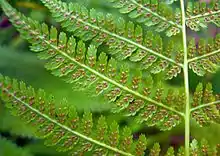Athyrium filix-femina
Athyrium filix-femina, the lady fern or common lady-fern, is a large, feathery species of fern native to temperate Asia, Europe, North Africa, Canada and the US.[1] It is often abundant (one of the more common ferns) in damp, shady woodland environments and is often grown for decoration.
| Athyrium filix-femina | |
|---|---|
 | |
| Scientific classification | |
| Kingdom: | Plantae |
| Clade: | Tracheophytes |
| Division: | Polypodiophyta |
| Class: | Polypodiopsida |
| Order: | Polypodiales |
| Suborder: | Aspleniineae |
| Family: | Athyriaceae |
| Genus: | Athyrium |
| Species: | A. filix-femina |
| Binomial name | |
| Athyrium filix-femina | |
Its common names "lady fern" and "female fern" refer to how its reproductive structures (sori) are concealed in an inconspicuous – deemed "female" – manner on the frond.[2] Alternatively, it is said to be feminine because of its elegant and graceful appearance.[3]
Characteristics

Athyrium filix-femina is now commonly split into three species, typical A. filix-femina, A. angustum (narrow lady fern) and A. asplenioides (southern lady fern).
Athyrium filix-femina is cespitose (the fronds arising from a central point as a clump rather than along a rhizome). The deciduous fronds are light yellow-green, 20–90 centimetres (7.9–35.4 in) long and 5–25 cm (2.0–9.8 in) broad. Sori appear as dots on the underside of the frond, 1–6 per pinnule. They are covered by a prominently whitish to brown reniform (kidney-shaped) indusium. Fronds are very dissected, being 3-pinnate. The stipe may bear long, pale brown, papery scales at the base. The spores are yellow on A. angustum and dark brown on A. asplenioides.
A. filix-femina is very hardy, tolerating temperatures as low as −20 °C (−4 °F) throughout its range.'[4]
Cultivation and uses
Numerous cultivars have been developed for garden use, of which the following have gained the Royal Horticultural Society's Award of Garden Merit:

The young fronds are edible after cooking; Native Americans cook both the fiddleheads and the rhizomes.[7]
References
- "Athyrium filix-femina". Germplasm Resources Information Network. Agricultural Research Service, United States Department of Agriculture.
- University of Wisconsin-Madison Arboretum, Lady-fern profile Archived 2013-09-27 at the Wayback Machine
- Wayside and Woodland Blossoms (1895) by Edward Step: "the Male-fern – so-called by our fathers owing to its robust habit as compared with the tender grace of one they called Lady-fern."
- "RHS Plantfinder - Athyrium filix-femina". Royal Horticultural Society. Retrieved 12 January 2018.
- "RHS Plantfinder - Athyrium filix-femina 'Vernoniae'". Royal Horticultural Society. Retrieved 12 January 2018.
- "RHS Plantfinder - Athyrium filix-femina 'Frizelliae'". Royal Horticultural Society. Retrieved 12 January 2018.
- Benoliel, Doug (2011). Northwest Foraging: The Classic Guide to Edible Plants of the Pacific Northwest (Rev. and updated ed.). Seattle, WA: Skipstone. p. 109. ISBN 978-1-59485-366-1. OCLC 668195076.
Further reading
- Hyde, H. A., Wade, A. E., & Harrison, S. G. (1978). Welsh Ferns. National Museum of Wales.
